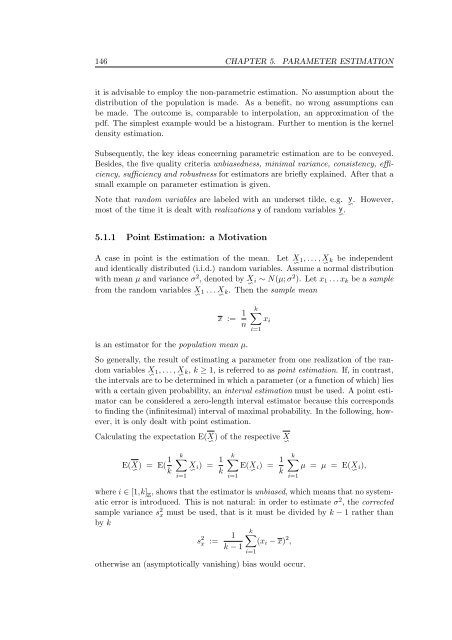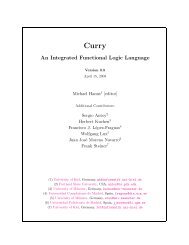Conformal Geometric Algebra in Stochastic Optimization Problems ...
Conformal Geometric Algebra in Stochastic Optimization Problems ...
Conformal Geometric Algebra in Stochastic Optimization Problems ...
Create successful ePaper yourself
Turn your PDF publications into a flip-book with our unique Google optimized e-Paper software.
146 CHAPTER 5. PARAMETER ESTIMATION<br />
it is advisable to employ the non-parametric estimation. No assumption about the<br />
distribution of the population is made. As a benefit, no wrong assumptions can<br />
be made. The outcome is, comparable to <strong>in</strong>terpolation, an approximation of the<br />
pdf. The simplest example would be a histogram. Further to mention is the kernel<br />
density estimation.<br />
Subsequently, the key ideas concern<strong>in</strong>g parametric estimation are to be conveyed.<br />
Besides, the five quality criteria unbiasedness, m<strong>in</strong>imal variance, consistency, efficiency,<br />
sufficiency and robustness for estimators are briefly expla<strong>in</strong>ed. After that a<br />
small example on parameter estimation is given.<br />
Note that random variables are labeled with an underset tilde, e.g. y ∽ . However,<br />
most of the time it is dealt with realizations y of random variables y ∽ .<br />
5.1.1 Po<strong>in</strong>t Estimation: a Motivation<br />
A case <strong>in</strong> po<strong>in</strong>t is the estimation of the mean. Let X ∽ 1,...,X ∽ k be <strong>in</strong>dependent<br />
and identically distributed (i.i.d.) random variables. Assume a normal distribution<br />
with mean µ and variance σ 2 , denoted by X ∽ i ∼ N(µ; σ 2 ). Let x1 ...xk be a sample<br />
from the random variables X ∽ 1 ...X ∽ k. Then the sample mean<br />
x := 1<br />
n<br />
is an estimator for the population mean µ.<br />
So generally, the result of estimat<strong>in</strong>g a parameter from one realization of the random<br />
variables X ∽ 1,...,X ∽ k, k ≥ 1, is referred to as po<strong>in</strong>t estimation. If, <strong>in</strong> contrast,<br />
the <strong>in</strong>tervals are to be determ<strong>in</strong>ed <strong>in</strong> which a parameter (or a function of which) lies<br />
with a certa<strong>in</strong> given probability, an <strong>in</strong>terval estimation must be used. A po<strong>in</strong>t estimator<br />
can be considered a zero-length <strong>in</strong>terval estimator because this corresponds<br />
to f<strong>in</strong>d<strong>in</strong>g the (<strong>in</strong>f<strong>in</strong>itesimal) <strong>in</strong>terval of maximal probability. In the follow<strong>in</strong>g, however,<br />
it is only dealt with po<strong>in</strong>t estimation.<br />
k�<br />
i=1<br />
Calculat<strong>in</strong>g the expectation E(X ∽ ) of the respective X ∽<br />
E(X ∽ ) = E( 1<br />
k<br />
k�<br />
i=1<br />
X ∽ i) = 1<br />
k<br />
k�<br />
i=1<br />
xi<br />
E(X ∽ i) = 1<br />
k<br />
k�<br />
µ = µ = E(X<br />
∽i), where i ∈ [1,k] � , shows that the estimator is unbiased, which means that no systematic<br />
error is <strong>in</strong>troduced. This is not natural: <strong>in</strong> order to estimate σ2 , the corrected<br />
sample variance s2 x must be used, that is it must be divided by k − 1 rather than<br />
by k<br />
s 2 x := 1<br />
k − 1<br />
k�<br />
(xi − x) 2 ,<br />
otherwise an (asymptotically vanish<strong>in</strong>g) bias would occur.<br />
i=1<br />
i=1
















